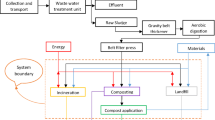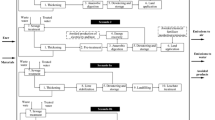Abstract
Background, Aims and Scope
Huge amounts of sewage sludge, that need to be handled, are generated all around the world from wastewater treatment plants and its management in an economically and environmentally acceptable way has become a matter of increasing importance during the last few years. In this paper, we make use of Life Cycle Assessment (LCA) to compare biological and thermal processes, that is to say, anaerobic digestion versus pyrolysis and incineration. This paper will complete the analysis performed in a wastewater treatment plant, where sludge post-treatment was identified as one of the main contributors to the environmental impact on the global system.
Methods
LCA is a tool for evaluating the environmental performance of goods as well as processes or services (collectively termed products). ISO 14040 defines LCA as a compilation and evaluation of the inputs, outputs and the potential environmental impacts of a system throughout its life cycle: from the production of raw materials to the disposal of the waste generated. In this study, data relating to the actual scenario from an existent wastewater treatment plant were considered. Both bibliographical and real data from existing facilities were used for the thermal processes proposed. The Centre of Environmental Science (CML) of Leiden University's methodology was chosen to quantify the potential environmental impacts associated with the different scenarios under study. The software SimaPro 5.1 was used and CML factors (updated in 2002) were chosen for characterisation and normalisation stages.
Results and Discussion
In a previous study, sewage sludge was found to be a critical point in the environmental performance of a wastewater treatment plant, so different alternatives have been tackled here. Anaerobic digestion followed by land application of pasty sludge comprises both energy recovery and nutrient recovery. Other thermal processes, such as incineration or pyrolysis, allow energy recovery (both electrical and thermal) and, although nutrients are lost, new co-products are produced (tar and char at pyrolysis). Here, the most adverse case (that is to say, the total amount of heavy metals is supposed to be released from the sludge and reach the environment) was applied to consider the most negative impact due to sludge spreading in agricultural soils; so more research is required in order to establish the precise amount of heavy metals that is effectively uptaken by the plants and crops as well as the amount that is transferred to another phase as a leachate. Thermal processes are presented here as a good option to recover energy from the sludge; although the value of nutrients is lost. Tar and char, co-products from pyrolysis, are good examples that were evaluated here, recycling of bottom ashes from sludge incineration or manufacture of ceramic materials from sludge are other options to be studied in the near future.
Conclusion
During the last few years, several opinions have been declared in favour of land application, incineration or pyrolysis, but many voices have also spoken out against each one. To obtain general conclusions for an overall comparison of different post-treatment of urban wastewater sludge is not easy as there are many contradictory aspects. The most effective utilisation of sewage sludge implies both energy and material re-use, but this is not always possible. Nevertheless, we think that land application of digested sludge is an acceptable option, probably not the best but at least a good one, for sludge treatment as long as efforts are focused on the minimisation of heavy metal content in the final cake.
Similar content being viewed by others
Author information
Authors and Affiliations
Corresponding authors
Rights and permissions
About this article
Cite this article
Hospido, A., Moreira, T., Martín, M. et al. Environmental Evaluation of Different Treatment Processes for Sludge from Urban Wastewater Treatments: Anaerobic Digestion versus Thermal Processes (10 pp). Int J Life Cycle Assessment 10, 336–345 (2005). https://doi.org/10.1065/lca2005.05.210
Received:
Accepted:
Published:
Issue Date:
DOI: https://doi.org/10.1065/lca2005.05.210




